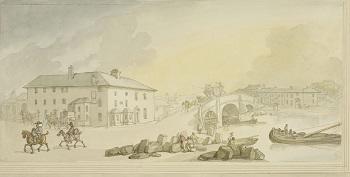
Views of England
Sketching journeys were popular with eighteenth-century artists, who sought picturesque views as sources for their art. In 1789, Rowlandson and his friend Henry Wigstead travelled on a sketching trip to Brighton (known as Brighthelmstone), an illustrated account of which they published in 1790.
Rowlandson often made day trips out of London, and he also took longer journeys, for example to Cornwall, where his patron Mathew Michell owned a house, and to Yorkshire to visit family members. He used all these trips to gather new material for his watercolours and prints.

Ferry Bridge, Yorkshire ©
Rowlandson probably made quick sketches on the spot to record the scenes he was witnessing. A number of sketchbook pages with quick pen-and-ink drawings survive. Once back at his desk, he turned these studies into finished watercolour views which were pasted onto lined mounts for sale to collectors.
Although Rowlandson did not intend his watercolour views to be humorous, the incidental figures that he added to the scenes often have the comical slant which is inescapable in his work.
Thomas Rowlandson (1757-1827)
Ferry Bridge, Yorkshire
Thomas Rowlandson (1757-1827)
Well at Harrogate, Yorkshire
Thomas Rowlandson (1757-1827)
Hampton Court: The West Front, from the tow path
Thomas Rowlandson (1757-1827)
Hampton Court from across the river
Thomas Rowlandson (1757-1827)
Old Kew Palace
Thomas Rowlandson (1757-1827)
Fishmarket at Brighthelmstone
Thomas Rowlandson (1757-1827)
The Post-House
Henry Wigstead (c. 1745-1800)
An Excursion to Brighthelmstone made in the year 1789
Thomas Rowlandson (1757-1827)
Stag Hunting scene in a park
Thomas Rowlandson (1757-1827)









